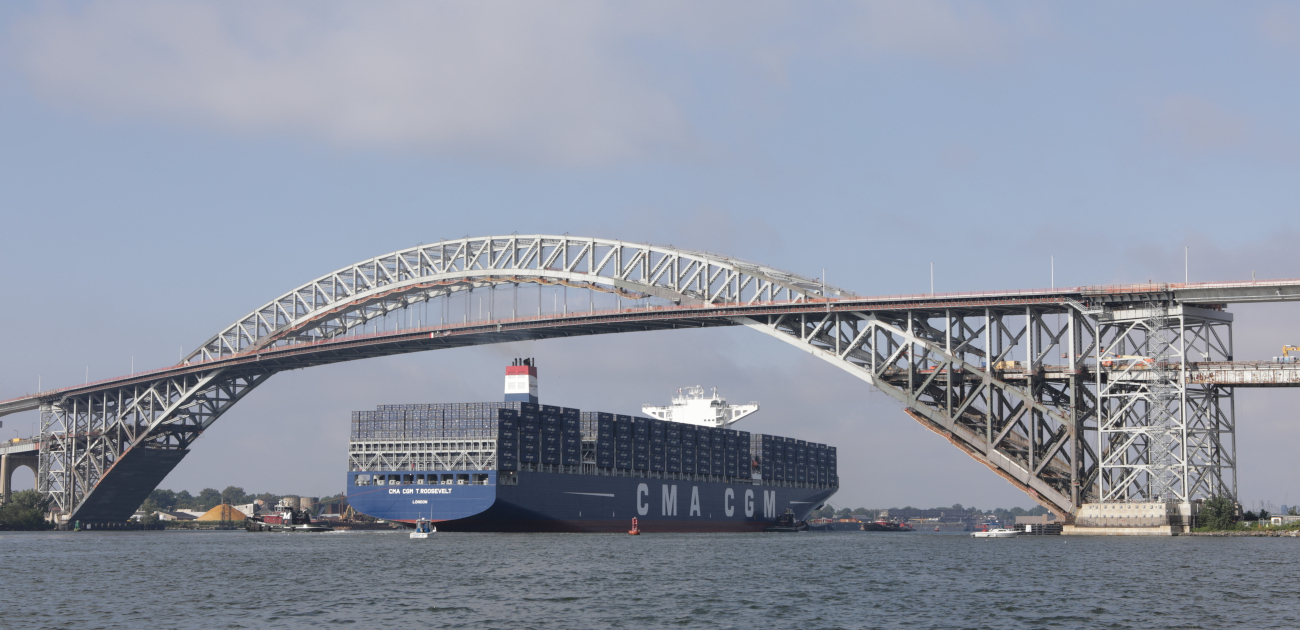
A 14,000+ TEU vessel (more than 1,200 feet long) is shown transiting the Kill Van Kull under the newly elevated Bayonne Bridge. At the time this photo was taken (2017), this was the largest ship ever to transit the newly expanded Panama Canal. [Photo submitted by PANYNJ]
The Port Authority worked in close collaboration with the design joint venture (HDR and Parsons Brinkerhoff/WSP, with AECOM as the sustainability consultant) and the construction joint venture (Skanska and Kiewit) to deliver this award-winning sustainable project.
Project context and scope
The Bayonne Bridge is the fourth-longest steel arch bridge in the world and was the longest in the world at the time of its completion in 1931. This historic engineering landmark, designed by American-Swiss structural engineer (and former Port Authority Chief Engineer) Othmar H. Ammann, spans the Kill Van Kull tidal strait, the narrow water body that connects New York Harbor to four of the Port Authority’s five major container terminals.
Built prior to the era of containerized freight, the bridge was originally constructed 151 feet above water. As a result of the bridge’s limited height, in recent years shippers had been forced to use smaller, less-efficient and less environmentally-preferable ships to bring goods into the region. To solve this problem, in 2010, the PANYNJ announced its decision preserve the Bayonne Bridge while raising its roadway deck to 215 feet to permit the passage of larger, more efficient vessels.
Benefits
In addition to preserving a landmark structure, this project benefits the New York-New Jersey region in many ways. Critically, larger, more efficient ships calling on PA ports yields better air quality for the region. The project also includes wider lanes, shoulders, and median dividers, which together make the bridge safer for drivers, and features a new bikeway and an ADA-compliant walkway. The bridge was also designed not to preclude future mass transit service.
Additional factors that contributed to the project’s Envision Silver award include:
Investing in the region: Between 2014 and 2018, the project supported nearly 2,800 jobs and provided more than $240 million in wages throughout the construction industry. In addition, an analysis completed by the U.S. Army Corps of Engineers found that raising the bridge will yield national economic development of more than $3 billion by preserving the long-term sustainability of local commerce and existing jobs in the region.
Preserving historic and cultural resources: The project preserved as much of the original bridge as possible, including the original steel arch. This strategy also reduced the project’s carbon footprint by minimizing the need to manufacture and transport new materials.
Managing sustainability throughout the project: The Port Authority implemented a robust sustainability management system from planning through construction. The project adhered to PANYNJ’s internal Sustainable Design Guidelines, which provided the primary framework for evaluating and implementing sustainable strategies. The PANYNJ Guidelines were found to integrate well with Envision.
Improving air quality: This project is anticipated to result in reduced regional emissions from vessels calling at the Port Authority’s terminals, due to the additional efficiencies of larger, newer ships. Furthermore, construction contracts required several mitigation measures to reduce air quality impacts during the project’s construction phase.
“The Port Authority’s strong commitment to sustainability and long-term regional economic development was manifested throughout the planning, design, and construction of the Bayonne Bridge Navigational Clearance Program,” said Melissa Peneycad, ISI’s Managing Director. “The historic significance of the Bayonne Bridge has been preserved for generations to come, while bringing the bridge up to the latest standards in accessibility and including sufficient flexibility for future enhancements such as the addition of mass transit. This is a project of which the region can and should be extremely proud. On behalf of ISI, I am pleased to award this project with Envision Silver for sustainable infrastructure.”


